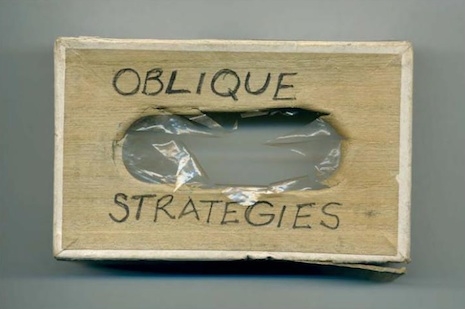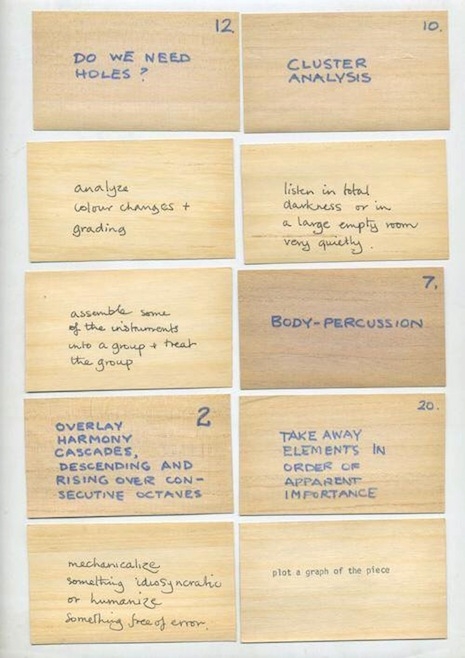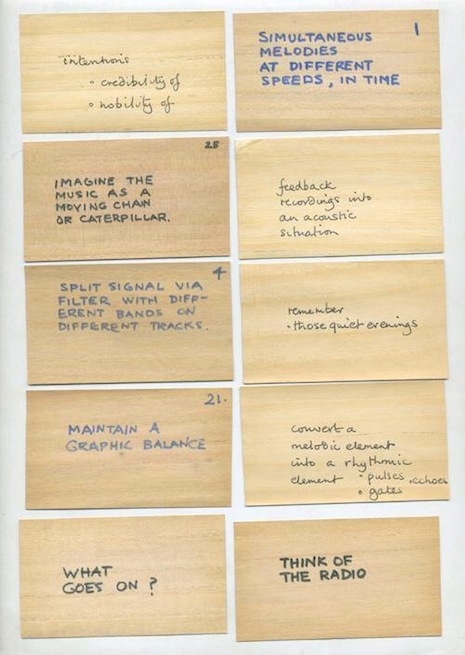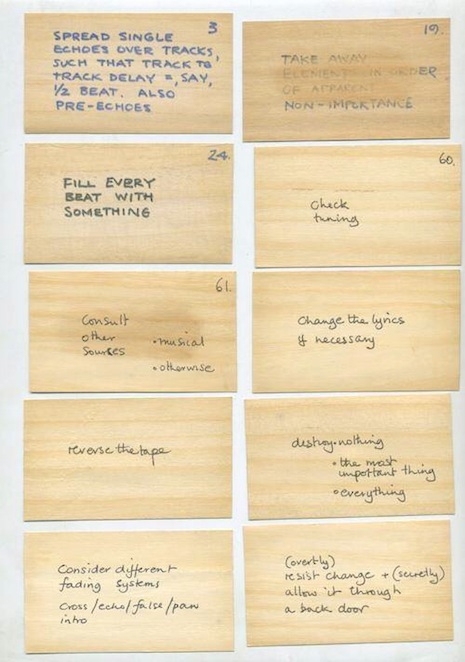
The concept behind Brian Eno and Peter Schmidt’s Oblique Strategies, a set of 115 cards with elliptical imperatives designed to spark in the user creative connections unobtainable through regular modes of work, is now a commonplace. Every Barnes & Noble sells kits for breaking writer’s block—hell, you can even buy them in the form of playing dice with questionably useful words like “REDEEM” and “TRAP” on them. In 1974, when the original Oblique Strategies set was developed, it was a more radical intervention with roots in Eastern philosophy.
In his college years Eno was fascinated by the Fluxus movement. Oblique Strategies was almost certainly inspired by George Brecht’s 1962 Fluxus work “Drip Music”:
George Brecht produced this thing called “Watermelon” or “Yam Box” or something like that. It was a big box of cards of all different sizes and shapes, and each cards had instructions for a piece on … All of the cards had cryptic things on them, like one said, “Egg event—at least one egg.” Another said, “Two chairs. One umbrella. One chair.” They were all like that, but the drip event one said, “Erect containers such that water from other containers drips into them.” That was the score, you see. I did a simple one which won an award.
Meanwhile, Peter Schmidt, a German composer and painter, had recently finished a project involving 64 paintings inspired by the I Ching.

Peter Schmidt and Brian Eno, London, ca. 1977
The cards had instructions like, “Honour thy error as a hidden intention” and “Remember those quiet evenings.” Here are some (not all) of the original cards. Both the cursive and the block print are Eno’s handwriting.





Sets of the cards have been available since the 1970s. The first four editions are out of print and collector’s items (and priced to match). The 5th edition is currently available from Eno’s website for £30 (about $50). In 2013 a limited 6th edition of 500 numbered sets were available but quickly sold out.
The following account comes from Brian Eno: Visual Music by Christopher Scoates:
Unlike the Fluxus scores that Eno had used years earlier, which were essentially directives for performance, the Oblique Strategies cards were idea-generating tools and tactics designed to break routine thinking patterns. While born of a studio context, Oblique Strategies translated equally well to the music studio. For Eno, the instructions provided an antidote in high-pressure situations in which impulse might lead one to default quickly to a proven solution rather than continue to explore untested possibilities: “Oblique Strategies evolved from me being in a number of working situations when the panic of the situation—particularly in studios—tended to make me quickly forget that there were other ways of working and that there were tangential ways of attacking problems that were in many senses more interesting than the direct head-on approach.”
In fact, while producing David Bowie’s album Heroes (1977), Eno and Bowie used Oblique Strategies on the song “Sense of Doubt.” They each picked a card but didn’t reveal its content. “It was like a game,” Eno recalled. “We took turns working on it; he’d do one overdub and I’d do the next. . . . As it turned out they were entirely opposed to one another. Effeciively mine said, ‘Try to make everything as similar as possible,’ and his said ‘Emphasize differences.’”
1977 “Sense of Doubt” video directed by Stanley Dorfman and reworked by Peter Wachsman:
Brian Eno discusses the Oblique Strategies cards with Jarvis Cocker in a 2010 BBC Radio 6 interview: